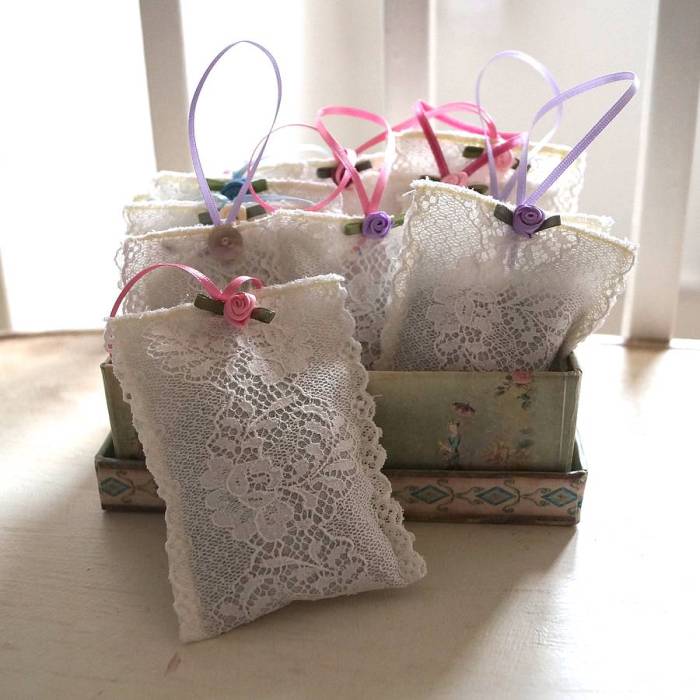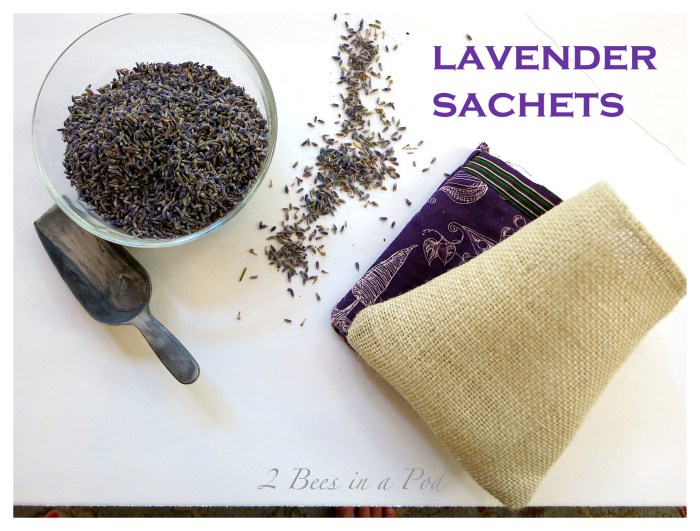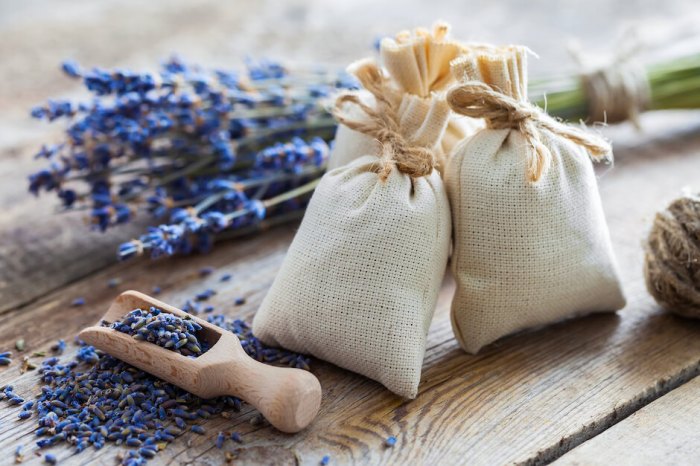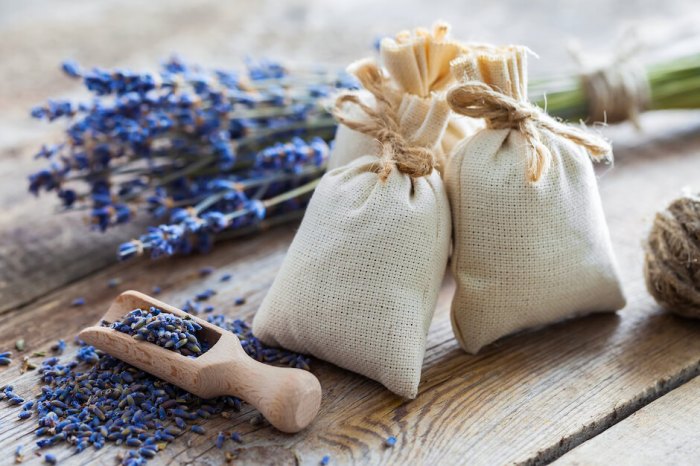Lavender Sachet DIY: Imagine a world filled with the calming scent of lavender, a world where stress melts away and sleep comes easily. This is the world you can create with your own lavender sachets, simple and affordable little bundles of tranquility.
From the history of lavender’s use in ancient times to its modern-day popularity in aromatherapy and relaxation practices, lavender sachets offer a timeless way to enhance your well-being. This guide will take you through the process of crafting your own lavender sachets, from choosing the right materials to filling and finishing your creations.
Introduction to Lavender Sachets
Lavender sachets, small fabric pouches filled with dried lavender flowers, have a rich history and cultural significance. Their use dates back centuries, with evidence suggesting they were employed for various purposes, including fragrance, relaxation, and even pest control. These delightful little bundles of fragrant lavender have become a cherished tradition, symbolizing tranquility and comfort.
Lavender sachets offer numerous benefits, making them a popular choice for home and personal use. Their soothing aroma, attributed to the presence of linalool and other compounds, promotes relaxation and reduces stress. The calming effects of lavender are well-documented, and lavender sachets can help create a peaceful and serene atmosphere, perfect for unwinding after a long day. Furthermore, the gentle scent of lavender is known to enhance sleep quality, making it an ideal companion for bedtime.
Creating your own lavender sachets is a simple and enjoyable DIY project. The process is straightforward, requiring only a few basic ingredients and materials, and can be customized to suit your preferences. This allows you to create personalized sachets that reflect your individual style and scent preferences. The affordability of this project makes it accessible to everyone, allowing you to enjoy the benefits of lavender sachets without breaking the bank.
Choosing Your Materials

Creating a lavender sachet involves selecting the right materials to ensure its fragrance, durability, and aesthetic appeal. The fabric you choose will influence the sachet’s look and longevity, while the filling materials determine its scent and texture. Let’s explore the various options and essential materials to get you started.
Fabric Options
The fabric you choose for your sachet will affect its appearance, durability, and ability to hold the scent.
- Cotton: A classic choice, cotton is breathable, readily available, and easy to sew. It’s a good option for beginners and offers a natural, unbleached look. However, cotton can be prone to wrinkling and may not hold fragrance as well as some other fabrics.
- Linen: Known for its durability and natural texture, linen is a good choice for sachets that will be handled frequently. It also has excellent breathability and holds fragrance well. Linen can be slightly more expensive than cotton and may require a bit more care.
- Silk: A luxurious and elegant option, silk adds a touch of sophistication to your sachets. It’s soft, smooth, and holds fragrance exceptionally well. However, silk is delicate and may require special care, making it less practical for everyday use.
- Muslin: A lightweight and breathable fabric, muslin is often used for sachets due to its ability to allow fragrance to diffuse easily. It’s also affordable and easy to work with.
- Velvet: A rich and luxurious fabric, velvet adds a touch of elegance to your sachets. It’s soft, plush, and holds fragrance well. However, velvet can be more difficult to sew than other fabrics.
Essential Materials
- Lavender Flowers: The heart of your sachet, choose high-quality, dried lavender flowers for the best scent. Look for lavender buds that are tightly closed and have a vibrant purple color. Avoid any flowers that are broken, crushed, or discolored.
- Filling Materials: Aside from lavender flowers, you can add other materials to enhance the scent or texture of your sachet. Popular options include:
- Dried Herbs: Chamomile, rosemary, and mint are great additions for a calming and refreshing scent.
- Dried Flower Petals: Rose petals, chamomile flowers, and calendula petals add visual appeal and a delicate scent.
- Dried Citrus Peels: Orange and lemon peels provide a zesty aroma and add a decorative element.
- Decorative Elements: To personalize your sachets, consider adding decorative elements like:
- Ribbons: Tie a ribbon around the sachet for a touch of elegance.
- Lace: Add a vintage touch with delicate lace trim.
- Embroidery: Personalize your sachet with a simple embroidery design.
- Buttons: Use decorative buttons to secure the sachet or add a unique touch.
Sourcing Quality Materials
- Lavender Flowers: For the best quality, consider purchasing lavender flowers from a reputable source specializing in dried herbs and flowers. Farmers’ markets and local herb shops are also excellent options. Look for lavender that has been carefully dried and packaged to preserve its scent and quality.
- Filling Materials: Dried herbs and flower petals can be found at specialty stores, online retailers, or even your local grocery store. Look for dried herbs that are whole, not crushed, and have a strong aroma. For flower petals, choose those that are vibrant in color and free of blemishes.
- Fabric: Choose natural fabrics like cotton, linen, or muslin from reputable fabric stores or online retailers. Look for fabrics that are free of chemicals and have a natural, unbleached color.
- Decorative Elements: You can find decorative elements like ribbons, lace, and buttons at craft stores, online retailers, or even your local thrift store. Choose elements that complement the fabric and overall design of your sachet.
Preparing the Lavender: Lavender Sachet Diy
Lavender flowers are a popular choice for sachets because of their calming aroma and relaxing properties. Before you can create your sachets, you’ll need to dry the lavender flowers.
Drying Lavender Flowers
Drying lavender flowers is a crucial step in preparing them for use in sachets. It helps to preserve their fragrance and potency. Here’s how to dry lavender flowers:
- Harvesting: Pick lavender flowers on a dry day, when they are in full bloom. The best time to harvest is in the morning, after the dew has dried. Cut the stems just below the flower heads.
- Air Drying: Tie the lavender stems together in small bunches and hang them upside down in a dry, dark, and well-ventilated area. Avoid direct sunlight, as it can fade the flowers and reduce their fragrance. The flowers should be completely dry within 1 to 2 weeks. You’ll know they are ready when the petals are brittle and crumble easily.
- Microwave Drying: You can also dry lavender flowers in the microwave, but this method may not be as effective as air drying. Spread the flowers in a single layer on a microwave-safe plate and heat them on low power for 1 to 2 minutes at a time. Continue heating until the flowers are completely dry. This method should take about 5 to 10 minutes.
Storing Dried Lavender
Once the lavender flowers are dry, it’s important to store them properly to maintain their fragrance and potency. Here are some tips for storing dried lavender:
- Airtight Containers: Store dried lavender in airtight containers, such as glass jars or metal tins. This will help to prevent moisture from entering and damaging the flowers.
- Cool, Dark Place: Store the containers in a cool, dark place, away from direct sunlight and heat. This will help to preserve the lavender’s fragrance and color.
- Labeling: Label the containers with the date you dried the lavender. This will help you to keep track of how long the lavender has been stored and ensure it is still fresh and potent.
Alternative Filling Materials
While lavender is a popular choice for sachets, you can also use other materials to create unique and fragrant sachets. Here are some alternatives:
- Dried Herbs: Other fragrant herbs, such as chamomile, rosemary, and mint, can be used to create relaxing and refreshing sachets.
- Essential Oils: You can add a few drops of essential oil to your sachets to enhance their fragrance. Some popular essential oils for sachets include lavender, chamomile, and eucalyptus.
- Rice: Rice can be used to add weight and texture to your sachets. You can also add a few drops of essential oil to the rice to create a fragrant sachet.
Sewing the Sachet
Now that you have your lavender and fabric ready, it’s time to sew your sachet. This section will guide you through the process of creating a simple lavender sachet, along with tips for adding decorative elements.
Basic Sachet Construction
To sew a basic sachet, you will need a piece of fabric that is twice the size of your desired sachet. For example, if you want a 4-inch by 4-inch sachet, you will need an 8-inch by 8-inch piece of fabric.
- Cut out the fabric: Cut two identical squares or rectangles from your chosen fabric. The size will depend on your desired sachet size. For a simple square sachet, cut two squares of fabric, and for a rectangular sachet, cut two rectangles.
- Pin the fabric together: Place the two pieces of fabric right sides facing each other. Pin them together around all four sides, ensuring the edges are aligned.
- Sew the fabric: Sew around the perimeter of the fabric, leaving a small opening for turning the sachet right side out.
- Turn the sachet right side out: Carefully turn the sachet right side out through the opening you left.
- Stuff the sachet: Fill the sachet with your prepared lavender.
- Close the opening: Hand-stitch the opening closed using a small running stitch or a blind stitch for a neat finish.
Sachet Shapes and Sizes
Here’s a table outlining various sachet shapes and sizes along with their corresponding fabric requirements:
| Shape | Size | Fabric Requirements |
|---|---|---|
| Square | 4 inches x 4 inches | 8 inches x 8 inches |
| Rectangle | 3 inches x 5 inches | 6 inches x 10 inches |
| Heart | 4 inches x 4 inches | 8 inches x 8 inches |
| Circle | 3 inches diameter | 6 inches diameter |
Decorative Sewing Techniques
To enhance the visual appeal of your lavender sachets, you can incorporate decorative elements like ribbons, buttons, and embroidery.
Ribbons
Ribbons can be sewn onto the sachet to create a decorative accent. You can sew the ribbon around the perimeter of the sachet or create a bow on the top.
Buttons
Buttons can be sewn onto the sachet to add a touch of whimsy. You can use a variety of buttons, such as fabric-covered buttons, wooden buttons, or vintage buttons.
Embroidery
Embroidery can be used to create intricate designs on the sachet. You can use a variety of embroidery stitches, such as a running stitch, a backstitch, or a satin stitch. You can also use embroidery floss in different colors to create a vibrant design.
Filling and Finishing the Sachet
Now that your lavender is ready and your sachet is sewn, it’s time to fill it with fragrant goodness! This step is where you can truly personalize your sachet by adding a touch of your own preferences.
Filling the Sachet
You’ll want to fill your sachet with enough lavender to create a strong, pleasant aroma, but not so much that it becomes overly bulky or difficult to sew shut. A good starting point is to fill the sachet about three-quarters full. You can always add more later if you prefer a stronger scent.
- If you’re using dried lavender flowers, you can simply pour them into the sachet.
- If you’re using a blend of lavender and other herbs or spices, mix them together before filling the sachet.
- If you’re using essential oils, add a few drops to the sachet before filling it with lavender.
Achieving Desired Scent Intensity and Longevity
The amount of lavender you use will affect the scent’s intensity and longevity. Here are some tips:
- For a stronger scent, use more lavender.
- For a more subtle scent, use less lavender.
- To extend the life of your sachet, you can add a few drops of essential oil to the lavender.
- Lavender essential oil is known for its calming and relaxing properties, and it can help to create a more peaceful atmosphere in your home.
Securing the Sachet
Once your sachet is filled, you’ll need to seal it securely to prevent the lavender from spilling out.
- If you’re using a sewn sachet, simply tie a ribbon or string tightly around the opening.
- If you’re using a fabric sachet, you can use a needle and thread to sew the opening closed.
- You can also use a fabric glue to secure the opening, but be sure to use a glue that is safe for fabric.
Creative Variations

Lavender sachets are a versatile craft, offering endless possibilities for personalization. You can tailor them to your taste and purpose, creating unique gifts or functional additions to your home.
Shape and Size Variations
The traditional rectangular shape is just a starting point. Experiment with different shapes and sizes to create unique sachets. For example, you can create heart-shaped sachets for Valentine’s Day, or small, round sachets to tuck into drawers. You can also make larger sachets for pillows or to hang in closets.
Decorative Elements
Embellishing your sachets with decorative elements can add a personal touch and enhance their aesthetic appeal.
- Lace: Adding lace trim around the edges of the sachet creates a delicate and elegant look.
- Beads: Beads can be sewn onto the sachet or strung together to create a decorative border. Choose beads that complement the color of your fabric and lavender.
- Charms: Small charms, such as flowers, butterflies, or hearts, can be attached to the sachet for a whimsical touch.
Alternative Uses
Lavender sachets have many uses beyond just scenting linens.
- Drawer Fresheners: Place a sachet in your dresser drawers to keep clothes smelling fresh and repel moths.
- Car Air Fresheners: Hang a sachet from your rearview mirror to create a calming aroma in your car.
- Gift Wrapping: Tie a sachet to a gift as a fragrant embellishment.
Storage and Maintenance
You’ve lovingly crafted your lavender sachets, and now it’s time to ensure their fragrance and effectiveness last. Proper storage and occasional refreshing will keep your sachets smelling delightful for months to come.
Storing Lavender Sachets
To preserve the lavender’s scent and prevent any unwanted pests, store your sachets in airtight containers. Glass jars or resealable plastic bags are ideal. Choose a cool, dark, and dry place to store your sachets, away from direct sunlight and moisture. Avoid storing them in humid environments, as this can encourage mold growth.
Gift Ideas

Lavender sachets make wonderful gifts for various occasions, offering a thoughtful and aromatic gesture. Whether you’re celebrating a birthday, expressing gratitude, or simply wanting to bring a touch of tranquility, these fragrant pouches are sure to be appreciated.
Presenting Lavender Sachets as Gifts
Presenting your lavender sachets thoughtfully enhances their impact. Here are some creative ideas:
- Personalized Packaging: Choose a box, bag, or even a small fabric pouch in a color that complements the lavender. Add a personalized touch with a ribbon, a handwritten tag, or a decorative sticker.
- Gift Baskets: Include your lavender sachets in a gift basket themed around relaxation, sleep, or aromatherapy. You can add items like essential oil diffusers, candles, herbal teas, or bath salts.
- Seasonal Touches: For holidays, consider incorporating seasonal elements into your presentation. For example, wrap sachets in festive paper or tie them with ribbon matching the holiday colors.
Labeling for a Personalized Touch
A handwritten label adds a personal touch and provides information about the contents of the sachet. Here are some labeling ideas:
- “Handmade with Love”: This simple phrase conveys your care and effort.
- “Lavender Sachet for Relaxation”: Clearly state the purpose of the sachet.
- “Happy Birthday”: Include a personalized message for the recipient.
Benefits of Gifting Lavender Sachets
Lavender sachets offer numerous benefits that make them ideal gifts for promoting relaxation, sleep, and aromatherapy.
- Relaxation: Lavender’s calming scent is known to reduce stress and anxiety, creating a peaceful atmosphere.
- Sleep: The aroma of lavender can promote restful sleep, helping to ease insomnia and improve sleep quality.
- Aromatherapy: Lavender essential oil is widely used in aromatherapy for its calming and soothing properties. Sachets offer a gentle way to experience these benefits.
Safety and Precautions
While lavender is generally considered safe, it’s important to be aware of potential allergens and take precautions when crafting and using lavender sachets.
Although lavender is known for its calming and relaxing properties, it can cause allergic reactions in some individuals. It’s essential to understand the potential risks and take appropriate measures to avoid any adverse effects.
Lavender Allergies
Lavender allergy is a common type of contact dermatitis, a skin reaction caused by direct contact with an allergen. Symptoms usually appear within 12 to 48 hours of contact and may include:
- Redness
- Itching
- Swelling
- Blisters
- Dryness
If you have a history of allergies, it’s recommended to perform a patch test before using lavender in sachets. To do this, apply a small amount of lavender oil or dried lavender to a small area of your skin and observe for any reactions. If you experience any symptoms of an allergic reaction, discontinue use and consult a healthcare professional.
Safe Handling of Essential Oils, Lavender sachet diy
Essential oils, including lavender oil, are highly concentrated and should be handled with care. Always dilute essential oils in a carrier oil, such as almond oil or jojoba oil, before applying them to your skin.
- Avoid direct contact with eyes and mucous membranes. If contact occurs, rinse thoroughly with water.
- Store essential oils in a cool, dark place, away from direct sunlight and heat. Exposure to heat and light can degrade the quality of the oil.
- Keep essential oils out of reach of children and pets. Children and pets are particularly susceptible to the effects of essential oils.
- Use essential oils in moderation. Overuse of essential oils can lead to skin irritation or other adverse effects.
General Safety Tips
Here are some general safety tips for crafting and using lavender sachets:
- Use clean tools and materials. This will help to prevent contamination and ensure the safety of your sachets.
- Wash your hands thoroughly after handling lavender or essential oils. This will help to prevent any accidental contact with your eyes or mouth.
- Do not use lavender sachets on infants or young children. Infants and young children are more susceptible to the effects of essential oils and may have sensitive skin.
- Avoid using lavender sachets on broken or irritated skin. Lavender can irritate broken skin, so it’s best to avoid using sachets on any areas that are damaged or irritated.
With a little creativity and a dash of lavender, you can create your own personal haven of peace and serenity. Whether you’re gifting a sachet to a loved one or adding a touch of tranquility to your own home, this DIY project is sure to bring a sense of calm and joy to your life.
A lavender sachet is a lovely addition to any drawer or linen closet, offering a calming aroma and a touch of elegance. If you’re looking for a fun and creative project, consider crafting a sachet inspired by Luna Lovegood, a quirky and imaginative character from the Harry Potter series. You can find inspiration for a Luna Lovegood costume DIY here , and use those same whimsical elements to create a unique and personalized lavender sachet.
The result will be a fragrant reminder of Luna’s spirit and a charming addition to your home decor.

